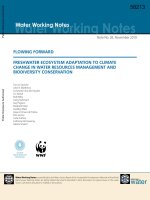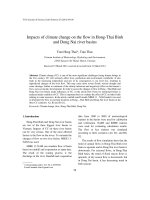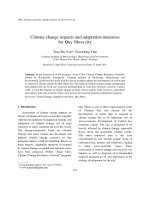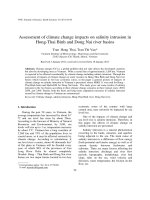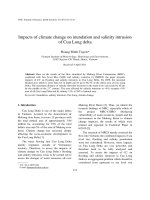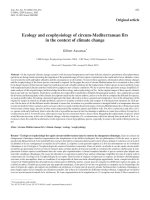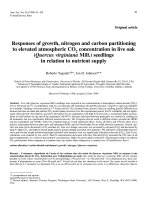Vulnerability and adaptation of coastal aquaculture and fishing households to impacts of climate change in quy nhon city
Bạn đang xem bản rút gọn của tài liệu. Xem và tải ngay bản đầy đủ của tài liệu tại đây (1.39 MB, 98 trang )
MINISTRY OF EDUCATION AND TRAINING
NHA TRANG UNIVERSITY
HUYNH NGUYEN PHUC
VULNERABILITY AND ADAPTATION OF COASTAL
AQUACULTURE AND FISHING HOUSEHOLDS TO
IMPACTS OF CLIMATE CHANGE IN QUY NHON CITY
MASTER THESIS
KHANH HOA – 2017
i
MINISTRY OF EDUCATION AND TRAINING
NHA TRANG UNIVERSITY
HUYNH NGUYEN PHUC
VULNERABILITY AND ADAPTATION OF COASTAL
AQUACULTURE AND FISHING HOUSEHOLDS TO
IMPACTS OF CLIMATE CHANGE IN QUY NHON CITY
MASTER THESIS
Major:
Marine Ecosystem Management
and Climate Change
Code:
772/QĐ-ĐHNT dated 20/9/2016
Topic allocation Decision
Decision on establishing the
Committee:
Defense date:
Supervisors:
1: PROF. JAHN PETTER
JOHNSEN
2: DR. NGUYEN LAM ANH
Chairman of Committee:
Faculty
Studies:
of
Graduate
KHANH HOA – 2017
i
UNDERTAKING
I undertake that the thesis entitled: “Vulnerability and adaptation of coastal
aquaculture and fishing households to impacts of climate change in Quy Nhon
City” is my own work. The work has not been presented elsewhere for assessment
until the time this thesis is submitted.
Nha Trang, April 28, 2017
Author
Huynh Nguyen Phuc
iii
ACKNOWLEDGMENT
I would like to express the deepest appreciation to the Graduate Study Faculty
of Nha Trang University for helping and giving me best conditions finish my thesis.
My special thanks to Prof. Jahn Petter Johnsen and Dr. Nguyen Lam Anh for
the continuous support of my Master study and research, for their patience,
motivation, enthusiasm, and immense knowledge. Their guidance helped me in
all the time of research and writing of this thesis.
I also would like to acknowledge and thank to Norhed program, University
of Nha Trang and Tromso for giving me the opportunity to study Marine
Ecosystem Management and Climate Change.
Last but not the least, I would like to thank my family: my parents and to my
brothers and sister for supporting me spiritually throughout writing this thesis.
Thank you!
………...,Date
month
year
Author
Huynh Nguyen Phuc
iv
TABLE OF CONTENTS
Undertaking ............................................................................................................... iii
Acknowledgement ..................................................................................................... iv
Table of contents ........................................................................................................ v
List of abbreviations ................................................................................................. ix
List of tables ............................................................................................................... x
List of figures............................................................................................................. xi
Abstract ..................................................................................................................... xii
CHAPTER 1. INTRODUCTION .............................................................................. 1
1.1. Introduction ......................................................................................................... 1
1.2. Thesis objectives and research questions ............................................................ 4
1.2.1. Thesis objective ................................................................................................ 4
1.2.2. Research questions ......................................................................................... 4
CHAPTER 2. THEORETICAL FRAMEWORK ...................................................... 6
2.1. Studies of climate change in Vietnam ................................................................. 6
2.2. The concepts of climate and climate change ...................................................... 7
2.3. Causes of climate change .................................................................................... 7
2.4. Sustainable livelihood framework and climate change ....................................... 8
2.5. Use sustainable livelihood framework to study impacts and adaptation to climate
change ........................................................................................................................ 8
2.6. Livelihoods assets ................................................................................................ 8
2.7. Livelihood strategies ........................................................................................... 9
2.8. Livelihood outcomes ........................................................................................ 10
2.9. Institutions and policies .................................................................................... 10
2.10. Vulnerability ability of coastal livelihoods to the impacts
v
of climate change ..................................................................................................... .11
2.11. Adaptation of coastal livelihoods to the impacts of climate change ............... 11
CHAPTER 3. METHODOLOGY ............................................................................ 13
3.1. Data Collection and Assessment ....................................................................... 13
3.2. The field-survey method ................................................................................. 13
3.3. Household interview ......................................................................................... 14
3.4. In-depth discussion ............................................................................................ 15
3.5. Key Informant Interviews.................................................................................. 16
3.6. Data analysis and processing method ................................................................ 17
CHAPTER 4. FINDINGS ABOUT CHANGES ..................................................... 18
4.1. General information of study area ..................................................................... 18
4.1.1. Natural and environmental characteristics of Nhon Ly commune ................. 20
4.1.1.1 Geography .................................................................................................... 20
4.1.1.2. Climate ........................................................................................................ 21
4.1.1.3. Hydrology ................................................................................................... 22
4.1.2. Production of Aquaculture and Captured Fishery .......................................... 23
4.2. Climate change ................................................................................................. 25
4.2.1. Climate change trend in Vietnam in the 21st century ................................... 25
4.2 2. Serious impacts caused by climate change in coastal areas of Vietnam ........ 27
4.2.3. Scenarios for climate change in Quy Nhon City ........................................... 30
4.2.4. Consequences of the above scenario in Quy Nhon City ............................... 31
4.3. Marine ecosystem under context of climate change ......................................... 31
4.4. Awareness of local people on impacts of extreme variations ........................... 34
4.4.1. Frequency ....................................................................................................... 34
4.4.2. Impact of extreme variations .......................................................................... 35
vi
4.4.2.1. Impacts on Aquaculture ............................................................................... 36
4.4.2.2. Impacts on fishing ....................................................................................... 37
4.4.2.3. Impacts on property and people of fishing and aquaculture households .... 39
CHAPTER 5. CAPITAL BASED ADAPTATION CAPACITY ............................ 42
5.1. Natural capital.................................................................................................... 42
5.2. Human Capital ................................................................................................... 42
5.3. Physical capital .................................................................................................. 44
5.4. Financial capital................................................................................................. 45
5.5. Social capital...................................................................................................... 47
CHAPTER 6. ADAPTATION MEASURES TAKEN BY FISHING,
AQUACULTURE HOUSEHOLDS AND LOCAL GOVERNMENT ................... 51
6.1. Adaptation in aquaculture.................................................................................. 51
6.2. Adaptation in fishing ......................................................................................... 52
6.3. Livelihood change ............................................................................................. 54
6.4. Ecosystem–based adaptation ............................................................................ 55
6.4.1. Locally managed marine area ........................................................................ 55
6.4.1.1. Organizational structure .............................................................................. 56
6.4.1.2. Implemented ativities .................................................................................. 56
6.4.2. Establishment of fishery- tourism cooperative under co-management team . 59
6.4.3. Activities of local government ....................................................................... 60
6.4.3.1. Preparation and cope with extreme variations ............................................ 61
6.4.3.2. Activities after storm and flood ................................................................... 62
CHAPTER 7. DISCUSSION .................................................................................. 63
CHAPTER 8. CONCLUSION AND RECOMMENDATION ................................ 66
8.1. Conclusion ......................................................................................................... 66
vii
8.2. Recommendations for future research and for provincial and local goverment,
local aquaculture and fishing housholds................................................................... 67
8.2.1. Monitoring, assessing and forecasting the impacts of climate change ........... 67
8.2.2. Research and proposed measures for the wild fisheries ................................. 67
8.2.3. Aquaculture .................................................................................................... 68
8.2.4. Policy related solutions................................................................................... 68
8.2.5. International cooperation ............................................................................... 69
REFFERENCES ....................................................................................................... 70
APPENDICES
viii
LIST OFABBREVIATIONS
CPC
Commune People’s Committee
CRSD
Coastal Resources Sustainable Development
DARD
Department of Agricultural and Rural Development
DECAPFIREP
Department of Capture and Fishery Resources Protection
DONRE
Department of Natural Resources and Environment
LMMA
Locally Managed Marine Area
MCS
Monitor, Control and Surveillance
MONRE
Ministry of Natural Resources and Environment
ix
LIST OF TABLES
Table 4.1: Fisheries capture production in Quy Nhon City ..................................... 20
Table 4.2: Aquaculture production of Quy Nhon City ............................................. 20
Table 4.3: Types of capture .................................................................................... 24
Table 4.4: Sea level rise scenario of Vietnam coastal area based on RCP scenario 27
Table 4.5: Biodiversity of Quy Nhon Bay................................................................ 33
Table 4.6: Awareness of local people on frequency of extreme variations ............. 34
Table 4.7: Awareness of local people on impacts of extreme variations on Aquaculture
households ................................................................................................................ 36
Table 4.8: Awareness of local people on impacts of extreme variations on fishing
households ................................................................................................................ 38
Table 4.9: Awareness of local people on impacts of extreme variations on property and
people of fishing and aquaculture households ......................................................... 40
Table 5.1: Social and demographic characteristics of interviewed households’
members.................................................................................................................... 43
Table 5.2: Fishing and aquaculture household’s assets with value of 3 million VND
ormore ...................................................................................................................................... 44
Table 5.3: Occupation of members in fishing and Aquaculture households ........... 45
Table 5.4: Income of household ............................................................................... 46
Table 5.5: Social classification due to income ........................................................ 47
Table 6.1: Adaptive measures of aquaculture households ....................................... 52
Table 6.2: Adaptive measures of fishing households ............................................... 53
x
LIST OF FIGURES
Figure 3.1: Taking secondary data from relevant agencies ........................................ 13
Figure 3.2: Ly Luong and Ly Hoa hamlets ............................................................... 14
Figure 3.3: Group interview (left) individual interview (right) .................................. 15
Figure 3.4: Two in-depth discussions ......................................................................... 16
Figure 3.5: Key informant interview .......................................................................... 16
Figure 4.1: Lobster seed hatchery area in Nhon Ly commune ................................... 24
Figure 4.2: Sea level rise has damaged and had impact on the coastal road .............. 25
Figure 4.3: Annually average temperature change (oC) based on the scenario
RCP4.5.......................................................................................................... 26
Figure 4.4: Annually average temperature change (oC) based on the scenario
RCP8.5 ....................................................................................................................... 26
Figure 4.5: Coral reef ecosystem of Nhon Ly coastal Commune .............................. 32
Figure 4.6: Locally managed marine area (LMMA) – Quy Nhơn Bay ................... 34
Figure 5.1: Establishement of Co-management team and MCS activities ................. 49
Figure 6.1: Luxury resort of FLC Group in Nhon Ly Commune ............................... 55
Figure 6.2: Organizational structure ........................................................................... 56
Figure 6.3: Community meeting for dissemination and awaness raise ...................... 57
Figure 6.4: Workshop on sharing LMMA implementation ........................................ 57
Figure 6.5: Making survey on biodiversity in LMMA ............................................... 58
Figure 6.6: Parking area and market supported by CRSD project in Nhon Ly ......... 59
Figure 6.7: Tourist buoy and coral viewing raft of tourism cooperative.................... 60
xi
ABSTRACT
Climate change is currently considered as a great challenge in the world.
Vietnam is regarded as one of the most vulnerable countries to climate change. Coastal
areas like Quy Nhon City in Vietnam has experienced extreme weather and climate
related variations like floods, drought, salt intrusion and sea level rise. Coastal
aquaculture and fishing households tend to be particularly vulnerable to impacts of
climate change due to limited adaptation capacity. They often live in areas that are
severely affected by natural disasters while their livelihoods depend on resources
adversely impacted by extreme variations. Therefore, adaptive activities play a critical
role in minimizing vulnerability, enhancing resistance to climate change and creating
sustainable livelihoods. This paper investigates vulnerability and adaptation of coastal
livelihoods to the impacts of climate change at household level in Nhon Ly Commune.
The study is based on a survey, interviews and discussions among households in Nhon
Ly Commune in Quy Nhon City. Findings showed that the intensity of extreme
variations in Quy Nhon City is huge although they don’t frequently occur. The
extrenme variations
have a severely impacts on local aquaculture and fishing
households. Furthermore, local people have learned how to adapt to changes in fishing
and aquaculture although their awareness of extreme variations and adaptive measures
is still limited. However, the capital-based adaptation in Nhon Ly commune is low in
general despite its rich natural resources and good community there. Finally, the
results show that local people and relevant agencies are active in coping with the
effects of extreme variations.
Key words: Extreme variations, coastal fishing and aquaculture households,
livelihood, vulnerability, adaptation.
xii
CHAPTER 1
INTRODUCTION
1.1. Introduction
Climate change in form of increased average global temperature and sea level
rise is considered as one of the greatest challenges of human in the 21st century (Dat,
2012). It is assumed that climate change will affect economy, society and
environment. Climate change may have serious impacts on production and life in the
world although not all consequences are clear. In particular, climate change in form of
higher water temperature, acidification and sea level rise may strongly affect
ecosystems and socio-economic activities in coastal areas (Monirul, 2013). The
livelihood of coastal people depending on natural resources may be sensitive to
climate change. Even moderate sea level rise and increase in frequency or strength of
storms make low islands and coastal plains particularly vulnerable (MARD, 2008).
With about 40% of the world population living in coastal areas around the world,
and still increase in the population, the coastal zones are under pressure. The
population increase in geographic areas exposed to natural disasters may increase the
climate change vulnerability (Dat, 2012). Therefore, coastal resident’s capacity to cope
with and adapt to climate change is important. Moreover, coastal people livelihood is
often in sectors that are sensitive to climate change, such as agriculture, forestry and
fisheries. Quite often the most vulnerable people have few other livelihood and work
opportunities. Therefore, if coastal people have limited capacity to adaptation and have
their livelihood in a climate sensitive sector, they may be among those people who are
most vulnerable to the negative impacts of climate change. This vulnerability may be
due to lack of social and economic capital to cope with these changes. Hence, reducing
vulnerability and enhancing adaptive capacity to climate change are of major
importance for the households and the communities.
Vietnam is exposed to climate change effects. Vietnam is located in a region with
a complex climate, close to the equator in the South, adjacent to temperate region in
the North. Both tropical dry air from the North and hot, humid air from the South
influence the climate of our country. Therefore, the climate is both temperate and
1
tropical. On the other hand, the East and the South coast of Vietnam are adjacent to the
Pacific Ocean and the Indian Ocean. The Western and Northern parts of the country
are adjacent to Eurasia continent. Thus, the climate has both oceanic and continental
features. It is these above factors combined with monsoon, and the tropical depressions
that cause the storms that hit the East Sea and that makes Vietnam’s coast exposed to
disasters (Piero, 2004).
Storms are important. According to the Vietnam Assessment Report on Climate
Change (ISPONRE, 2009), it has been shown that there are storms in the South China
Sea almost every month, especially from May to November. In this period there can be
about 15 tropical low pressures and storms forming in the East Sea. About 60% of the
storms come from the Western Pacific, while 40 % of storms are formed and increase
in strength in the South China Sea. Storm or tropical low pressure often happens every
year (before 1975: 0.7, after 1975: 1.13) from September to December. Moreover,
strong and very strong storms have become more frequent. All these storms and
tropical low pressures have a direct impact on Vietnam's weather. The storms bring
with them heavy rain, causing flows and inundation in residential areas. International
studies have shown that Vietnam is considered as one of the countries that may be
heavily affected by climate change (Dasgupta et al., 2007). Especially, the Mekong
Delta is one of three areas in the world that are most vulnerable by sea level rise
(ISPONRE, 2009).
Coastal areas and islands of Vietnam consist of three regions: North, Central and
South. All these areas are affected by climate phenomena. Storms and tropical low
pressure are prominent in the Central area, while floods and landslides are common in
the coastal areas of North and Central (MONRE, 2016). Since it is in the coastal areas
that are municipalities, the service sector and industries are localized and develop.
According to the report on Vietnam fisheries in 2015, Vietnam has 3,260 km of
coastline and an Exclusive Economic Zone (EEZ) of 200 nautical miles. The
production potential in the EEZ and the territorial waters are estimated to more than 3
million tons of seafood. The dense system of bays, coastal lagoons, richness of
aquaculture species, abundant labor resources provide coastal areas of Vietnam with
good conditions of fishery development. Sectors like tourism and fisheries are
2
assumed to be affected by climate change in the future. Capture of wild fish and
aquaculture produce both for domestic consumption and export of fisheries products.
This creates jobs for fishermen and helps protect the security and sovereignty on the
sea by maintaining operation of fishing vessels and civil activities on the sea. Our
authorities mean that “Fishermen are an extremely important force in marine economic
development closely linking with national defense and security. The presence of
fishermen on the sea not only asserts the national sovereignty but also directly
participate with the relevant forces in responding to every situation” (Ha et al, 2017).
Quy Nhon City is located in the South of Binh Dinh Province, with a coastline of
more than 40 km. It is the economic, political and social center of the Binh Dinh
Province. Fishery is a key economic sector in the City. However, Quy Nhon City has
experienced extreme variations and weather related to phenomenon, such as: floods,
drought, salt intrusion, sea level rise, etc the recent years (Huy, 2012). These events
may also have caused human, natural and material damages.
We may assume that global warming and sea level rise in the future can increase
the frequency and level of inundation and flooding, accelerate coastal erosion and
cause that sea water encroach into freshwater bodies. Moreover, tidal water has deeply
invaded into estuaries and river systems. The fisheries and aquaculture sectors may be
affected by climate change. Areas for production can be affected by change in
temperature and species composition may change. Increased temperature can also
cause ocean acidification that may affect the productivity in the ecosystems. Thus,
economic activities can be expected to be strongly affected by climate change in the
future.
Floods and storms may destroy infrastructure and have effect on activities in the
coastal zone. Since there are many coastal aquaculture and fishing households in Quy
Nhon City, impacts of climate change can have consequences for the population.
Clearly, future climate change may in fact be one of the biggest challenges to coastal
livelihood in Quy Nhon City. These households have already experienced extreme
variations in form of storms, temperature increase, heavy rain, flood, drought and sea
level rise and salt intrusion (Huy, 2012). For example, the storms cause rain, high
wind, and lead to flooding. Wastewater treatment works and system of drains are
3
destroyed by floods which make waste, garbage and waste water from toilets and
breeding establishments directly overflow into and pollute the environment. Finding
ways to adapt to climate change is therefore a critical issue for the national, regional
and local government as well as for the coastal households themselves.
With the above reasons, the author conducts the research on “Vulnerability and
adaptation of coastal aquaculture and fishing households to impacts of climate change
in Quy Nhon City”. The purpose of this study is to evaluate how the impacts of
climate on aquaculture and fishing activities are perceived by the local fishing
population. These perceptions may have relevance for their ability to adapt to longterm climate related changes. Based on the findings, the author will propose
reasonable solutions and strategies that may enhance fishermen’s ability to cope with
more complex climate change in Quy Nhon City and in Binh Dinh Province.
As a case for the master thesis, the author chooses the coastal commune Nhon Ly
of Quy Nhon City. The selection of location to conduct research is based on two
criteria: (i) the main livelihoods of these communes are aquaculture and fishing. (ii)
Aquaculture and fishing activities, fishery related households in the commune are
impacted by weather conditions and potential climate change.
1.2. Thesis objectives and research questions
1.2.1. Thesis objective
This study aims to identify perceptions weather and climate related changes and
of vulnerability and adaptive capacity by coastal aquaculture and fishing households in
Quy Nhon City, and propose appropriate adaptive strategies.
1.2.2. Research questions
In order to achieve the objectives, this study will answer the following research
questions: What are the reported frequencies and impacts of climate change variations
on coastal aquaculture and captured fisheries in Nhon Ly Commune, Quy Nhon City?
•
How do the coastal aquaculture and fishing households perceive and deal
with weather and potential climate change impacts?
•
How is capital-based adaptive capacity of aquaculture and fishing
households?
4
•
What can be the appropriate adaptation measures?
•
Do provincial and local governments have appropriate adaptation measures?
The structure of the thesis is as follows. Chapter 2 defines concepts and describes
some indicators for climate change, it presents the analytical framework. I used the
sustainable livelihood framework to study adaptation to climate change. In Chapter 3,
the methods used in the research are described. Chapter 4 presents findings about
change.
Chapter 5 presents findings about fishing and aquaculture household’s
capacity in climate change adaptation through five capitals.
Chapter 6 presents
findings about adaptation measures taken by fishing, aquaculture households and local
government. In Chapter 7 the results are discussed. Finally, Chapter 8 concludes and
outlines some recommendations.
5
CHAPTER 2
THEORETICAL FRAMEWORK
2.1. Studies of climate change in Vietnam
In general, two aspects applied in the studies about vulnerability and adaptation
of coastal households to climate change are identified as follows: (i) coastal
livelihoods in the world and Vietnam are coping with challenges caused by
consequences of climate change; (ii) households need to implement proactive activities
in adaptation to the impacts of climate change in the world and in Vietnam. These
studies have been done by Shelton (2014), Gbetibouo (2009), Islam (2013), Marshall
et al (2010), MONRE (2016), Dat et al (2012),Huy (2012), etc.
It is recognized that previous studies on vulnerability and adaptation of coastal
households to climate change mainly mentioned to the following main issues: (i)
livelihood capital analysis of the coastal households; (ii) how climate change has been
happening and scenarios of climate change in coastal areas in the future are predicted;
(iii) who is most severely impacted by consequences caused by climate change in
coastal areas; (iv) awareness of coastal households on the frequency and intensity of
climate change on their livelihood; (v) assessment of vulnerability and impacts of
climate change on fishery- based livelihood; (vi) activities of coastal households at all
levels in climate change adaptation; and (vii) recommendations for local people and
governments in coping with risks of climate change.
Main findings from these studies include: (i) capital–based adaptive capacity of
coastal households is weak, (ii) Currently, climate change is more and more severe
and unusual; (iii) those who are most vulnerable to the impacts of climate change
women, the elderly, and children; (iv) local people’ awareness on climate change is
limited in general, (v) impacts of climate change make production activities differently
vulnerable mate change, (vi) local people has applied flexible changes to deal with
impacts of climate change; and (vii) some adaptive livelihood strategies in fisheries as
well as government policies to support households to improve their adaptive capacity
have been proposed for coastal communities.
6
Although some studies (Huy, 2012; IWE, 2009) on impacts of climate change in
Quy Nhon City have been conducted, such issues as vulnerability and adaptation
capacity of coastal livelihoods to the impacts of climate change have not been
addressed in a comprehensive manner to provide a basis for the development of
sustainable and adaptive livelihoods for coastal fishing and aquaculture households.
2.2. The concepts of climate and climate change
Weather is what’s happening outside at a given location, which is identified
through factors, such as: temperature, pressure, humidity, wind speed, rain, etc.
Climate is the average of weather observation during many years “usually 30 years”
(Dat, 2012). It is identified by accurate meteorological parameters in long term and at
a given place, such as: temperature, precipitation, etc. Moreover, climate is influenced
by geographical factors and ocean currents. The weather change daily and can occur as
unstable. Climate change is more than weather variations, it is a long- term change
overwide areas. The change can be measured over long time. Changes can be caused
by natural and human factors. Climate change is currently expressed by global
warming, sea level rise and increase of extreme variations, namely: flood, drought,
storms (MONRE, 2009).
It is also necessary to distinguish between climate variability and climate change.
Climate variability occurs over seasons and years. For example, it is colder in some
summers and more precipitation in some years. Meanwhile, climate change is a longterm continuous increase or decrease of average weather conditions (e.g. average
temperature) or the extreme weather (e.g. drought, storms, etc). While climate
variability can be perceived year-to-year, climate change is a slow and gradual change
over several decades.
2.3. Causes of climate change
There are can be many factors behind climate change. The natural factors
including continental drift, volcanic eruption, oceans, clouds, wildfires directly affect
climate of the earth in different ways (Trang, 2012). However, human activity gives a
main contribution to climate change through over emission of CO2 and other green
house gases of which the Earth can’t absorb all. If there are no greenhouse gases in the
7
atmosphere, the average temperature on the Earth is 0o F (equivalent to -18oC), the
Earth’s surface is frozen and life on the earth can’t exist. However, when greenhouse
gases are much emitted in the atmosphere and the Earth can’t absorb the residue
amount, the average temperature on the Earth will increase, which result in climate
change (USAID, 2009).
2.4. Sustainable livelihood framework and climate change
Sustainable livelihoods framework consists of five elements that together
interact. These are: (i) livelihood assets; (ii) livelihood strategies, (iii) livelihood
outcomes, (iv) institutions and policies at different levels, (v) external factors. The
framework describes the methods households can use sustain living based on the
existing livelihood assets under certain conditions, institutions and policy. The assets
are impacted by external factors, such as: shocks (storm, flood, conflict between
resource users, etc), trends (changes in temperature and rainfall, increased poverty,
etc) and seasonality (change on price, production activities, etc.) (DFID, 2001).
2.5. Use sustainable livelihood framework to study impacts and adaptation to
climate change
Climate change is a key factor increasing the vulnerability of coastal
communities. Therefore the sustainable livelihood framework is a useful framework
for study impacts and adaptation to climate change. First of all, climate change does
affect livelihood assets, especially natural capital (such as land, water, and fisheries
resources) and physical capital (such as roads, irrigation systems, and power network).
They are all sensitive to climate change. When the livelihood assets are vulnerable to
the impact of climate change, livelihood strategies will be affected, which in turn will
affect livelihood outcomes. In the context that climate change is increasingly complex
in the future (DFID, 2001).
2.6.
Livelihoods assets
The livelihood assets of fishery-dependent people can be grouped into five
categories: natural, physical, human, financial and social capital. Human access to
livelihood assets is considered as central element in the approach to sustainable
livelihood.
8
Natural capital includes the available resources in the natural environment that
people can use to carry out livelihood activities, such as land, coastal resources, water
resources, etc. Natural capital in the fisheries sector are natural resources that
fishermen whose livelihoods depend on fisheries rely on for living. Physical capital
includes system of infrastructure (fishing port, landing site, road, houses, schoold,
markets, etc) and production equipment supporting livelihood activities (fishing gears,
processing equipment, etc).
Financial capital includes the various sources that people use to achieve
livelihood objectives including cash, loans, and other income, etc. Residents of coastal
communities are very difficult to access loans because they do not have valuable assets
as collateral. They can only receive high-interest loans with terms unfavorable to them.
Therefore, those whose income depends on fisheries often lack the financial ability to
cope with the difficulties when incident occurs due to impact of climate change.
Human capital includes the skills, knowledge, educational level, experience of
production, working ability, health, etc. which help people to perform various
livelihood activities and achieve desired livelihood outcomes. ”Human capital is
essential to effectively using the other four types of capital” (Monirul, 2013)
Social capital includes the social relationships and networks (political and civil
organizations, members of communities) on which people rely on to implement
livelihood activities. ”Social capital enables people to build collective actions and act
together more effectively to pursue shared objectives” (Monirul, 2013)
2.7. Livelihood strategies
Livelihood activity is how households use the available livelihood capital to earn
living and meet the need of life. Households with the socio-economic characteristics
and the different livelihood assets should have the different choice of livelihood
models. The livelihood activities which can be done are agriculture production,
fisheries and aquaculture, trade, etc.
Livelihood strategies of households reflect how a household use the possible
assets to meet the requirements of livelihood. We can review case of livelihoods in the
9
fisheries sector in which a fishing household seeks food and creates income through
fishing. To do that, the household need to use a few possible assets as follows:
- Physical assets include vessels, fishing boats, fishing nets, jetties, roads
- Human assets include knowledge and experience in fishing, health and labor.
- Natural resources include fish captured from the sea, marine ecosystems (coarl
reef, mangrove, seagrass, etc.).
- Financial assets include money borrowed from the budget, relatives or the
collectors,etc.
Because income from one source is often uncertain, a household should have
several different methods to seek food, a few different sources of income, or a few
different ways to create income. Activities can always change or change to adapt
certain events like rain, storm or in stages of scarce income sources. These activities
include livelihood strategies of households. A very important thing is that in coastal
communities there may have several different household groups with the different
socio-economic characteristics of and various approaches to different resources. So
they will have different livelihood issues and solutions (DFID, 2001).
2.8. Livelihood outcomes
The livelihood outcomes including poverty reduction, well-being, employment
possibility, adaptation capacity to risks and sustainability of natural resource base are
the achievements that households get when combining the different livelihood capitals
to implement livelihood activities. Livelihood outcomes mainly include increased
income, improved well-being, reduced risk, enhanced food security, more effective use
of resources, etc (DFID, 2001).
2.9. Institutions and policies
Institutions, laws and policies play an important role in the successful
implementation of livelihood. They are developed and operated at all levels, from the
household level to higher level, such as: regional, national, etc. Institutions and
policies can decide access to livelihood capitals and the implementation of the
livelihood activities of individuals, households and others (DFID, 2001).
10
2.10. Vulnerability ability of coastal livelihoods to the impacts of climate change
Natural resources play a very important role to the poor fishermen who much
depend on fish stock and marine ecosystem. Meanwhile, natural resources, such as:
land and water are easy to be hurt by climate change. In addition, infrastructures such
as: system of dikes, irrigation, fishing ports and landing sites, boats and gear, etc. are
physical capital which is easy to be affected by the impacts of climate change. That
climate change impact on physical assets can result in financial loss. Households may
displace and resettle when the physical capital (such as: infrastructure; fishing boat and
gear) is damaged, which lose cost. Conflicts between resource users may be created by
climate change, which may harm the social relationship among households as well as
fishing communities. Weather extreme events (such as: cyclones, floods, storm, etc.)
may make
fishers harmful even loss of life, which can affect social- economic
activities of other members in the household or seriously affecting physical ability of
fishers in getting their livelihoods. How households select livelihood strategies and
achieved livelihood outcomes will be affected by the impacts of climate change on the
livelihood assets.
Climate change makes the livelihoods which rely on the natural resources of
coastal communities easier to get vulnerability. Fishing and aquaculture are main
livelihoods of the poor in coastal areas who mainly rely on natural assets to implement
livelihood strategies. (Dat, 2012)
2.11. Adaptation of coastal livelihoods to the impacts of climate change
The ability to cope with climate change is factor to assess the adaptation capacity
of a community to climate change not only to reduce vulnerability and damages that
may occur caused by climate change but also to take opportunities brought by climate
change. The adaptation capacity to climate change much impacts the vulnerability
possibility of a certain area. "One area will be more vulnerable if its adaptive capacity
is low. However, high adaptive capacity doesn’t mean that the region is not vulnerable
to the impacts of climate change” (Dat et al, 2012).
There are several types of adaptive strategies. They can be categorized in the
following way:
11
Based on the time when adaptive measures are carried out:
Anticipatory adaptation: The damage caused by the impact of climate change
can be avoided if communities and households proactively implement adaptation
activities. This is a proactive strategy based on observation, perception and
anticipation. It requires knowledge and capacity to understand and analyze a situation.
Reactive adaptation: After the impact of climate change has occurred and caused
the damage, communities and households carry out reactively adaptive activities to
mitigate loss. It requires resources to understand and mitigate consequences (Smith
and Wandel, 2006).
Based on policy on which individuals and organizations rely to carry out
adaptive measures:
Autonomous adaptation: When the impacts of climate change occur, relevant
individuals and organizations will deal with through a temporary and spontaneous
changes made in the short term. Hence, passive adaptation is usually carried out in
short term to cope with impacts of climate change without policy consideration.
Planned adaptation: Relevant individuals and organizations will be involved in
planning, selecting and applying appropriate policies to have proactive and strategic
solutions in limiting the consequences caused by climate change. Therefore, active
adaptation consists of long–term strategic changes to resolve the risks related to
climate change (USAID, 2009).
Based on those who carry out adaptive activities:
Private adaptation: Individuals, households and enterprises themselves
implement adaptive measures. One of the key policies is building capacity for
households on climate change.
Public adaptation: Central and local government implement adaptive measures.
Government plays a vital role in creating enable policy, financial and legal
frameworks, sharing experience and raising public awareness on climate change (Dat
et al, 2012).
12
CHAPTER 3
METHODOLOGY
3.1. Document collection from relevant agencies
Relevant documents are assessed to supplement data. They are collected from
official and unofficial documents, statistical report, research report, experience, which
are provided by DARD, DECAFIREP, DONRE (Trang, 2012).
Figure 3.1: Taking secondary data from relevant agencies
3.2. The field-survey method
The author carried out a survey in the fishing community in the whole commune
where extreme variations frequently occur. After consulting the recommendations of
the management staffs at the provincial level, such as: DECAFIREP, DONRE,
People's Committee of Quy Nhon City, the author selected Ly Luong and Ly Hoa
hamlets as the representative study areas. The thesis has chosen the period 2011-2015
for the study because there have been many extreme variations that strongly impact on
livelihood of the households during the period when the results show changes in
frequency and intensity of extreme variations, assess adaptive capacity of the
households through changes in livelihoods or use of the experiences in their life to
cope with impacts of extreme variations. For example, there are, in 2012, some storms
and low tropical depressions consecutively occur and cause great damages on human
and property in Quy Nhon (Quy Nhon PC, 2012). The historical timeline is five years
13
